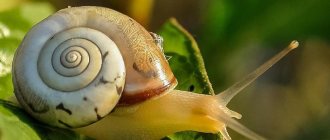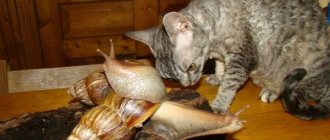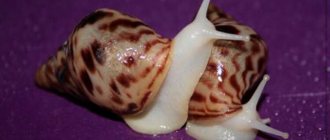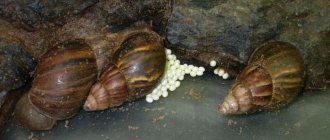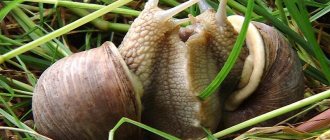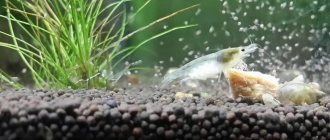If two adult Achatina of the same species live in a terrarium and you have created conditions suitable for reproduction for them, then after some time eggs will definitely appear in the ground. And even if your Achatina lives alone, but was previously kept with other adults, this will not become an obstacle to breeding offspring.
This happens because after mating, the future Achatina mother can carry the biomaterial within herself for about 2 years and gradually fertilize the mature eggs. Achatina females bear their offspring for about two weeks, then lay small white “pearls” in the ground. The clutch can be numerous from 100 to 300 eggs! The breeder needs to freeze some of the eggs and leave only the required amount, from which small Achatina snails will soon hatch.
How do Achatina hatch?
Types of domestic snails
There are certain types of snails that are quite friendly and very interesting to watch.
Nowadays you can find several types of snails in pet stores that you can keep at home. Types of domestic snails:
- Achatina fulica
- Achatina reticulata
- Achatina immaculata
- Achatina albopicta
- Brown Achatina
- Albino. It has an unusual appearance, a white body, and a dark shell. They are highly valued among breeders, their price is much higher than standard specimens
- African snails
They can reach sizes of more than 30 cm in length. Their weight can be around 0.5 kg. These are truly gigantic specimens. With proper care, such snails can live for 9 years. The average life expectancy is 6 years. The main advantage of such pets is that they do not crap in the house, do not damage furniture, and practically do not cause any inconvenience. But this does not mean that you do not need to take care of them.
Achatina
Achatina snails - what to feed and how to care for them?
Snails, like any pet, need a certain temperature, humidity, and appropriate feeding. Below we will consider the conditions for keeping snails. Regardless of the type of snail, the conditions for keeping it are almost the same. You need a large aquarium or container with transparent walls, approximately 25 cm high, 25 cm wide, and 40 cm long. Such snails do not grow well in very cramped containers. A regular snail jar will not be enough.
Achatina snails - what to feed and how to care:
- It is necessary to adhere to temperature standards and humidity parameters. The best option is a temperature of 24-28 degrees. In this case, it is necessary that the humidity of the snail house is at the level of 85-90%.
- Such high standards can be achieved by constantly moistening the substrate, which is located inside the container. The ideal option is a large aquarium with a lid, with holes for ventilation.
- At the bottom of the container it is necessary to lay out the appropriate substrate on which the snail crawls in natural conditions. It can be sand, soil, compost, peat. It is possible that there is an artificial material, which is sprinkled with natural material on top. Sawdust and shell rock are unacceptable substrate options. Such flooring becomes clogged with the snail's mucus and can damage its body. Therefore, it is necessary that there are no sharp pebbles or particles with sharp cutting edges in the soil.
- In addition, you can grow green salad in the soil that is in the aquarium. This is not only greens, but also a kind of delicacy for your pet.
Care
How many times should I feed Achatina snails?
Regarding feeding, it is recommended to feed snails once a day, early in the morning. It is best to use fruits and vegetables, as well as protein products, for these purposes. In most cases, green salad, cucumbers, and cabbage suit snails very well.
How many times to feed Achatina snails:
- It is recommended to spray the soil, that is, moisten it. Please note that in such conditions mold and pathogenic microorganisms multiply very quickly. Therefore, daily remove any leftover food that the snail has not eaten.
- Under no circumstances should you leave them inside the aquarium, as mold usually forms on top of the food, and eating such food can cause the snail to get sick and feel unwell. In addition, once a week it is necessary to completely change the soil, which is located on top of the aquarium. As for the cleanliness of the walls and top of the aquarium, they must be wiped with a damp cloth daily.
- Under no circumstances should you use aggressive chemicals for cleaning. For these purposes, you need to use regular baking soda or just vinegar and soap. The snail can absorb chemical residues, which can cause health problems.
Domestic snail
Use in cosmetology: benefit or harm?
Today, mollusks are actively used in cosmetology. Scientists have discovered that Achatina mucus contains a lot of allantoin, elastin, collagen, peptides, glycolic acid and arathan sulfate.
Note! Many components of mucus perfectly rejuvenate human facial skin.
Table: benefits
| Slime Component | Properties |
| Allantoin | Regenerates the skin, fights free radicals |
| Peptides | Destroy pathogenic organisms |
| Vitamins A, C and E | Relieve inflammation on the skin, moisturize it |
| Collagen | Promotes the synthesis of natural collagen |
| Glycolic acid | Cleanses the skin |
Snail mucus is usually not harmful. It is not recommended to use them in cosmetology for people with hypersensitivity or allergic tendencies.
Before the snail procedure, apply a little mucus to your wrist to test for allergens. If the skin is covered with red spots, itches and itches, then it is undesirable to use snails.
Massage procedures are very popular in cosmetology. The snail is washed and placed on the person’s face for a certain time.
Massage helps:
- Narrow pores.
- Get rid of expression wrinkles.
- Get rid of bags under the eyes.
- Prevent skin peeling.
- Increase the elasticity of facial skin.
The snail has gone into hibernation - what to do?
It is also necessary to pay a lot of attention to the health of the snail. When temperature and humidity rise or fall sharply, the snail may hibernate. In general, all pets, when properly maintained, do not hibernate. That is, they constantly delight their owners.
The snail has gone into hibernation, what to do:
- Therefore, if your pet is very lethargic, moves little, often hides in its shell, it may be preparing to hibernate. This means that the conditions and conditions have changed not for the better.
- Perhaps these are errors in nutrition or maintenance. Therefore, we recommend monitoring the temperature, humidity, and feeding habits of the snail. At this time, it is best to introduce foods that contain a lot of calcium.
- Recommends adding eggshells to meet calcium needs. Be sure to install a pool inside the aquarium. Don't forget to weigh it down, especially if your pet is large. Such a pool increases the humidity level in the aquarium; if necessary, the snail can cleanse its body.
Achatina
Taking care of your sink
A healthy and intact shell is an important sign of the health of the mollusk. It requires proper care. In order for the shell to be strong and quickly recover when chipped, the snail must have constant access to calcium supplements (sepia, powdered eggshells, natural chalk without additives).
If the sink is cracked or chipped, treat the damaged surface with an antiseptic to prevent infection. During the healing period, it is better to place the mollusk in a separate tank, provide it with calcium and carefully monitor its nutrition. The snail will heal the damage on its own.
Diseases of Achatina snails
Shellfish, like any pet, can get sick. Among the most common diseases, the following should be highlighted.
Diseases of Achatina snails:
- Damage to the shell. This happens when a snail falls, which is why it is recommended to use foam mats as bedding. However, many snails can get sick and do not respond well to artificial flooring. Next, you must also try to correct the damage to the shell.
- This can be done using epoxy glue. A large number of foods containing calcium are introduced into the diet. This will help restore the shell faster and improve your pet's health.
- Mold infestation. The snail becomes lethargic and may hibernate. In this case, a large amount of mucus is released, or vice versa, the snail dries out.
- Please note that the snail should not hibernate for more than 2 months. After 2 months she needs to be woken up. For these purposes, you can perform several simple manipulations:
- Hold your pet under warm water for a few seconds. Transplant it into an aquarium that has been prepared in advance. That is, with wet soil, food and a pool. Be sure to include foods rich in protein and calcium. This will help your pet regain all its strength faster.
A pet
Domestic snails: reproduction
Snails, regardless of their species, can reproduce even without a second partner.
Domestic snails, reproduction:
- Some of them are viviparous, some lay eggs. If you do not want your pet to have cubs, then you need to reduce the thickness of the soil to 2 cm.
- Snails that lay eggs do so only in a fairly dense and thick layer of soil.
- Snail eggs require special care and special nutrition. The eggs, after the snail has laid them, must be transferred to another aquarium and kept separately.
- They are buried in soil 1 cm thick. It should be soft and loose. After about 1-3 weeks, small snails will hatch.
Snail
What to feed aquarium snails?
Aquarium snails differ from Achatina in their structure, care features, and feeding methods. But if you have an aquarium with a lot of green algae, you won’t have to feed the snails. After all, their main food is algae and green spaces.
What to feed aquarium snails:
- In addition, they finish the fish’s food and often remove the rotting remains of dead fish, consuming waste. Of course, they will never bypass the fish, since they are less nimble, but what settles on the bottom begins to rot, the snails pick up and eat.
- This has a good effect on the condition of the aquarium, as it is cleaned. Aquarium snails with a lack of algae can be supplemented with cabbage, green salad, spinach, and carrots. These snails are omnivores, so they consume protein foods.
- You can add a small amount of boiled meat and caviar. Please note that you should not overfeed snails, as improper feeding provokes the release of a large amount of excrement, which will quickly make the water in the aquarium cloudy.
Garden snails
Seaweed
Algae are the main food source for snails. Algae grows well in an aquarium without fish. The more light that enters the aquarium and the higher the water temperature, the faster and more algae multiply on the walls, decorations and plants. Most snails remove algae from healthy plants but leave the plants alone.
What to feed large snails?
The diet of Achatina differs significantly from the diet of aquarium snails.
What to feed large snails:
- The diet should contain proteins and carbohydrates. The ideal option would be to consume a small amount of boiled meat, and a variety of fruits and vegetables. Under no circumstances should snails be given spicy or bitter vegetables or fruits.
- Also prohibited are beans, onions, garlic, boiled and fresh potatoes, as well as pasta and flour products. Snails can do almost everything else. Under no circumstances should you give junk food such as chocolate, sausage and frankfurters. In other cases, the snail is mainly fed vegetables and fruits. Indeed, in nature, Achatina enjoys sweet fruits and eats leaves.
What to feed the domestic snail Achatina in winter?
Unlike nature, food fed at home contains little calcium and protein, so it must be supplemented.
What to feed the domestic snail Achatina in winter:
- This can be done by grinding egg shells, bone meal, and crushed chalk.
- Do not use school chalk under any circumstances, as it contains many preservatives and additives that can harm the health of Achatina.
- You need to feed once a day, preferably in the morning. Never leave leftovers for the next day.
- Early the next morning, remove any leftovers that the snail did not eat.
Pet
Prevention
Follow the rules of hygiene: wash your hands before contacting your pet with plain water without using chemicals, promptly clean the container or terrarium from mucus and food waste. Prevent food from rotting and choose healthy foods.
The best prevention is proper care, timely cleaning of the terrarium and complete treatment or replacement of the soil every six months.
What to feed newborn snails?
For adult and small snails, food should not be placed on the ground or bedding during feeding. For these purposes, select a plastic plate or some kind of container. Under no circumstances should food become covered with soil particles and rot inside it. Otherwise, snails can eat rotting food, which often leads to esophageal disorders in mollusks.
What to feed newborn snails:
- Regarding newborn snails, calcium-rich foods must be included in their food. However, in no case should you add calcium gluconate, or Calcium D3 Nycomed. They contain a large number of preservatives, gelatin and other impurities that can cause the death of a pet.
- Accordingly, only natural sources of calcium are allowed, that is, such as chalk sold in a pet store, or eggshells crushed in a coffee grinder. Be sure to include sepia in your food.
- This is the skeleton of a cuttlefish, which is ground with a coffee grinder to a powder. Newborn snails need a lot of calcium. This is due to the fact that the shell grows, and a lot of trace elements are needed for its construction. Accordingly, all food given to small snails is sprinkled with a calcium supplement.
- This could be crushed eggshells or chalk. At the very beginning, it is necessary to give newborn snails grated cucumber and chopped carrots, as well as pumpkin and cabbage. At the age of 1-2 weeks, small snails are accustomed to fresh fruit. That is, you can introduce apples, pears and other fruits. All this must be crushed on a grater or using a blender.
- It is necessary that vegetables and fruits be small pieces. Be sure to purchase daphnia at the animal market, as it contains a lot of protein necessary for the development of the snail’s body. Don't be surprised if newborn snails burrow deep underground. There they eat the remains of their eggs. They contain a lot of useful substances, as well as protein. They help snails develop and grow.
Achatina
Adviсe
- Place shellfish in accessible areas, but not in hallways.
- Don't feed too much spinach.
- Ensure optimal humidity levels and constantly monitor the temperature in the terrarium.
- Peaches cause watery mucus, so it is best to exclude this fruit from your diet.
- Animals love cucumbers and sometimes refuse to eat other foods, but cucumbers are harmful to them.
- Avoid drafts.
- Avoid contact of mussels with salt, sugar and chemicals.
What to feed hatched snails?
Children should always have access to food. However, this does not mean that it is necessary to introduce new ones to the old products that you added yesterday. Under no circumstances should this be done.
What to feed hatched snails:
- In the first week, it is recommended to feed newborn snails exclusively with parsley and carrots.
- From the second week it is allowed to give lettuce leaves. Gradually the number of products and range is expanding. Please note that unlike adults, newborn snails need to be fed around the clock.
- Every 6 hours it is necessary to remove old products and add new ones. Stale products become weathered and pathogenic microorganisms can develop on their surface. Vegetables, as well as greens for Achatina, must be washed, even doused with boiling water.
- This will prevent infection by pathogenic microorganisms. In addition, nitrates, or traces of mineral fertilizers, often accumulate on the leaves, which can adversely affect the health of the pet.
Snails
Permitted cultivated herbs (greens)
These include greens, which we ourselves often add to salads or eat just like that, as well as tops:
- leaf lettuce - frillis, oakleaf, the most common - any cultivated leaf lettuce
- dill
- parsley
- carrot and beet tops
- microgreen sprouts - for example, pea greens or mung beans
- asparagus
- spinach
If you buy microgreens for a snail, look at what herbs it is grown from. If it is mustard greens, you should not give it. Try it yourself - if the grass is bitter or has a mustard taste, you should not give it to the snail.
Dill
In addition to the above, you can include leaves of fruit trees and berries in your diet:
- raspberries
- cherries
- apple trees
- strawberries and wild strawberries
In limited quantities you can:
- celery
- cilantro
- basil
- fenugreek herb
According to my observations, my pet is indifferent to such herbs, which is why I don’t collect them. And in general, the leaves of trees are mostly dry, which is why snails don’t like them.
Iceberg lettuce
The TOP 3 of cultivated herbs are:
- Lettuce - any options
- Microgreens
- Beet and carrot tops
She is more indifferent to other herbs and only eats when hunting.
Domestic snails: care and maintenance, reviews
Of course, snails are one of the varieties of exotic pets, but there are breeders who love to work with snails. Oddly enough, in the United States there are criminal penalties and even imprisonment for snail farming. The fact is that snails in America are considered a natural disaster, since in some regions they eat crops and even eat plaster on houses.
Domestic snails, care and maintenance, reviews:
Valeria, 25 years old . I got Achatina at the request of my 5-year-old son. We were walking home after the rain and saw a large garden snail. The child asked to take her home with him. I found a lot of information on the Internet about care. We had an old aquarium after the fish died, so we decided to place the snail in it. I didn’t know what she was eating or how to care for her, so she put regular soil on the bottom that she dug up on the street. She gave salads, carrots, cucumbers and cabbage as food. I didn’t buy anything special, I sprinkled the food with chalk and crushed chicken egg shells. I really like my pet, he has been living with us for 3 years. Once fell into hibernation. This is due to the fact that I placed the aquarium not far from the heating radiator. Perhaps the aquarium became too dry, so the snail went into hibernation.
Elizaveta, 30 years old . We purchased an African snail from a pet store. Its price was small, my daughter begged for it. I had to purchase an aquarium along with the snail. In general, the purchase of a pet resulted in a decent amount of money, since along with all this they also sold food and a calcium supplement. Unfortunately, the snail did not live with us for long; it fell into hibernation after six months; unfortunately, we could not wake it up. The entire contents of the sink are dry. I attribute this to non-compliance with temperature and humidity conditions. After all, I am at work very often, so there is no way to constantly spray the soil and keep it clean.
Anatoly, 48 years old. My grandson asked for a pet like this. He visits us often, so I wanted to please the baby. The most interesting thing is that I am very used to our Lisa, we even came up with a nickname for the pet. She is very interesting, unusual, friendly. We bought it in a small size, like a five-kopeck coin, and now the pet has grown about 5 times. The snail is really very big.
Achatina
In our country, everything is different, there are not so many snails, so they often buy such pets because they are inexpensive and do not require special care.


